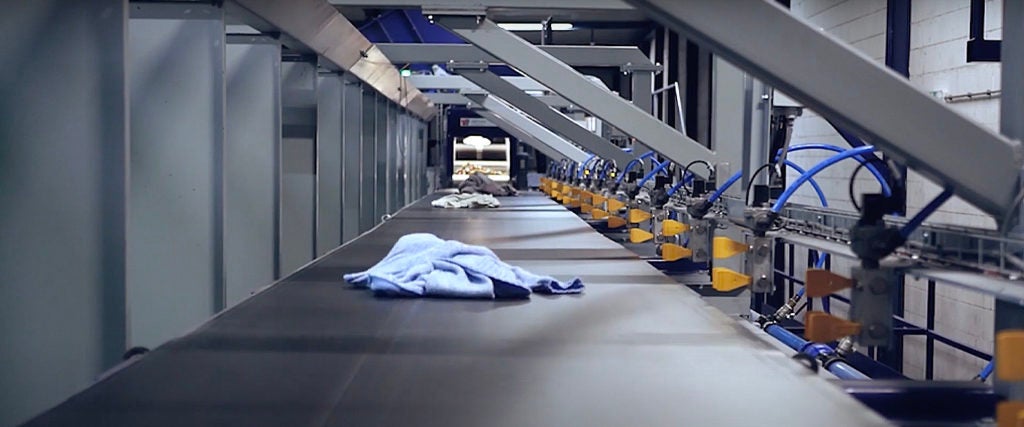Maurits Vandeputte is a project manager with Valvan Baling Systems, an engineering company that’s been developing a solution to help mitigate the seemingly unsolvable riddle that is sustainable fashion. It’s called Fibersort, and it’s a near-infrared-based technology that can categorize textiles into 45 different fractions via fiber composition and color, and can sort around one ton of post-consumer textiles per hour.
In many ways, post-consumer waste (i.e., the clothes consumers discard every year) is the fashion industry’s biggest problem — or maybe better put, the culmination of so many of its ills — as billions upon billions of pounds of it have been piling up in makeshift textile mountains across the world (and especially the developing world). To date, it’s also been incredibly hard to recycle or reuse — no matter what the agents of fast fashion or places like Goodwill may promise. “The fabrics we cover our bodies with consist of blends of natural yarns, human-made filaments, plastics and metals,” I reported earlier this fall. “To recycle these materials takes a lot of effort.”
Fibersort, which looks like a small-scale race track, aims to fix a lot of this — and Vandeputte insists that other than struggling to detect elastane, which is found in spandex and Lycra, and having trouble automating the removal of buttons, zippers and labels, it’s otherwise ready to go.
The bigger issue, he says, is that there are currently too few manufacturers and brands using recycled content. Not that it’s all their fault. “The processes aren’t there because the feedstock isn’t available, and the feedstock isn’t there because there are no recycling processes using the feedstock,” Vandeputte tells me. “It’s a little of a chicken and the egg thing.”
To that end, Vandeputte says that he’s had many conversations with big brands explaining Fibersort and its capabilities. “But they’re not the end-user of this technology,” he explains, the suppliers are. And so, they would need to demand that their suppliers use recyclable materials that Fibersort helps create.
What’s stopping brands from doing just that? In a word: compliance.
Per Vandeputte, nobody can currently guarantee that there are no forbidden substances in recycled textiles. “Here’s an example: You go on holiday to a different country and buy a T-shirt that was treated with forbidden chemicals,” he says. “The T-shirt will end up in the end-of-life textiles circuit after a while and ‘pollute’ the stream.” And since all the major brands consider this a major risk to their supply chain, they’re not yet willing to fully embrace recycled, post-consumer textiles.
In fairness, their concerns are genuine. In 2019, H&M and Ikea partnered to run thousands of tests on recycled materials to better understand how they could use them, collecting 166 samples of cotton-based textiles, mostly from donated clothes. “Then they shredded the samples and spent months running them through chemical analysis in 8,000 tests,” Fast Company reported. “The companies found chromium compounds (a carcinogen), heavy metals used in dyeing, in 8.7 percent of the samples, and alkylphenol ethoxylates (an endocrine disrupter), used in making dyes and pigments, in 19.3 percent of samples.”
Which is why perhaps the only solution at the moment is each major fashion company taking responsibility for their own textiles. To do so, they could motivate customers to return old clothes by offering reduction vouchers for new purchases. The concept, which has been around since at least 1990, is referred to as “extended producer responsibility” (EPR), and it basically means that the producer of a garment is responsible for managing its end-of-life in an environmentally responsible way.
France is the only country to implement an EPR policy for clothing, linen and shoes, but it’s been successful. “This EPR policy has contributed to a 150 percent increase in the collection rate of post-consumer textiles since 2007, which is estimated to be about 35 percent of all textile waste generated in France,” wrote the authors of a 2019 report on textile waste.
Not that EPR is perfect. In California, a carpet EPR law established an industry-controlled, nonprofit to oversee the program that led to a strategy that leaned too heavily on incineration. “In 2017, the state revised the law to now discourage incineration and to set minimum goals for materials recovery that increase gradually over time,” per a 2018 report in Waste Dive.
All of which is to say, even with a better sorting/recycling tool like Fibersort, there is no silver bullet to the textile waste crisis. Nonetheless, Vandeputte says, “There are more and more initiatives that are now stimulating recycling and also the development of missing technologies.” And so, he’s very optimistic that eventually someone (or something) will be able to thread this needle.

